Exploring Corrosive Environments
Think Protection Against Corrosion
Exploring Corrosive Environments
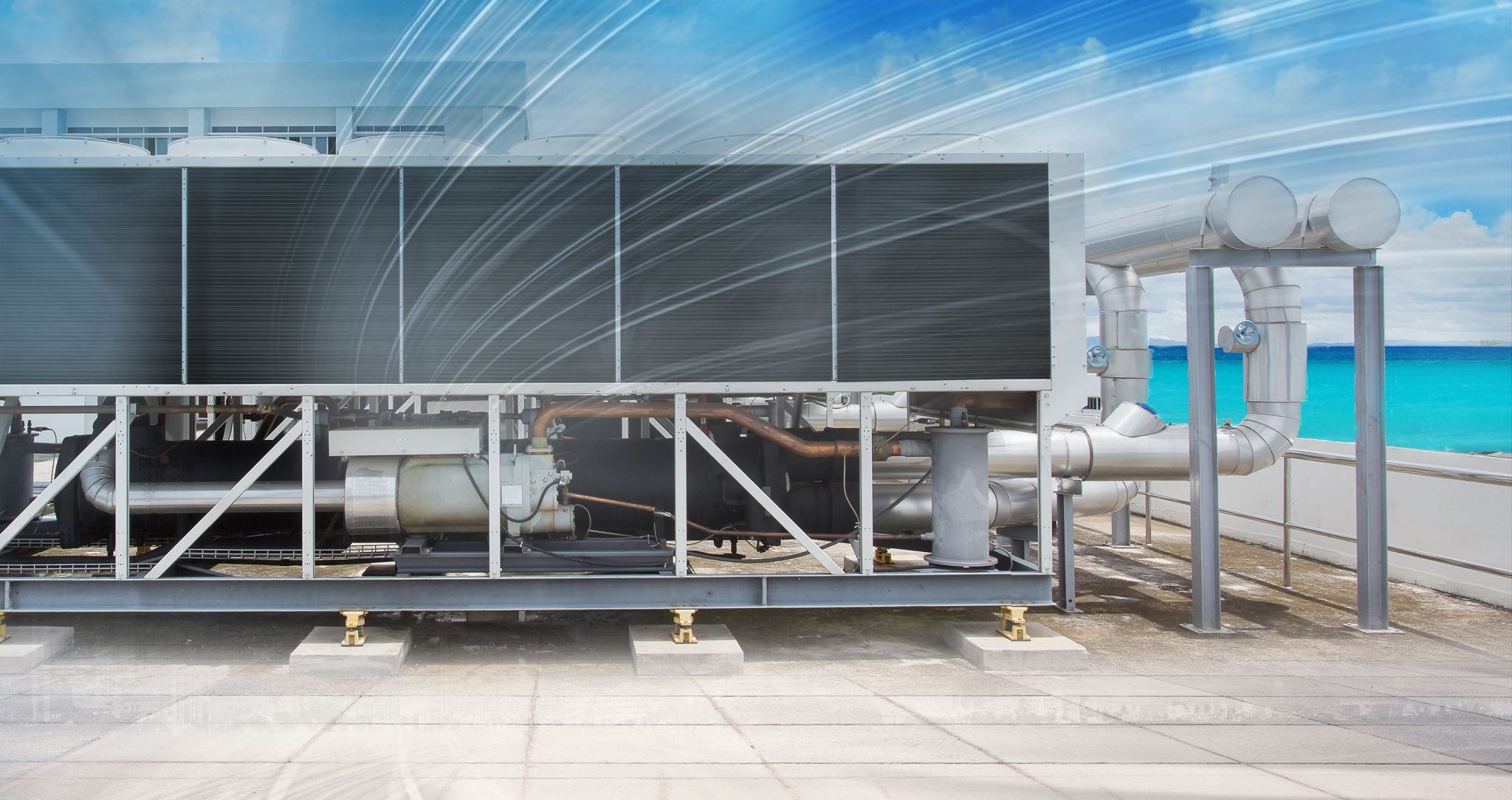 Corrosion is the destruction of material, usually metal or alloy, by chemical reaction with its environment. Corrosion can proceed in a general manner (general corrosion) or in a more localized manner (galvanic corrosion, pitting corrosion, formicary corrosion), depending on conditions and the material systems used. There are many types of corrosion; however, the most common types of corrosion within air conditioners are galvanic corrosion and general corrosion. Formicary corrosion also affects copper. These two corrosive processes can occur in as little as a few weeks after installation. More typically, corrosion will begin appearing within a one to four-year period. A protective coating will create a barrier between the metallic couple and the electrolyte, thereby eliminating the electrolyte, which is one of the causes for corrosion.
Corrosion is the destruction of material, usually metal or alloy, by chemical reaction with its environment. Corrosion can proceed in a general manner (general corrosion) or in a more localized manner (galvanic corrosion, pitting corrosion, formicary corrosion), depending on conditions and the material systems used. There are many types of corrosion; however, the most common types of corrosion within air conditioners are galvanic corrosion and general corrosion. Formicary corrosion also affects copper. These two corrosive processes can occur in as little as a few weeks after installation. More typically, corrosion will begin appearing within a one to four-year period. A protective coating will create a barrier between the metallic couple and the electrolyte, thereby eliminating the electrolyte, which is one of the causes for corrosion.
General Corrosion
General corrosion is a type of corrosion that takes place at almost the same rate on the surface of the entire metal that is exposed to the corrosion-causing conditions. Unprotected metal surfaces will continue to react with the contaminant, resulting in overall evasive corrosion and jeopardizing the efficiency and life of the HVAC/R equipment. General pollution, especially in industrial environments, can lead to tube leaks and failure of the refrigeration system. Sulfur and nitrogen-based electrolytes in combination with chloride environments are often the cause of accelerated corrosion of these metals.
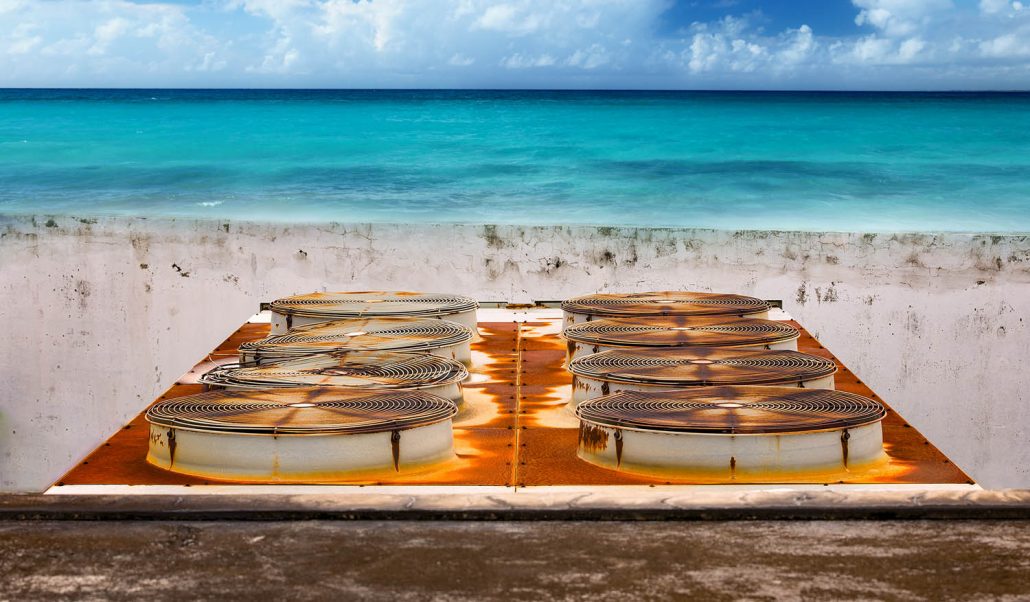
- Most mechanical engineers think only of coastal regions as corrosive environments, and therefore typically specify protective coatings for equipment used in these regions. But corrosion can occur in industrial areas, urban or rural areas, localized microclimates, and combinations of these conditions. Beyond these areas, the presence of flue gas, sewage vents, open sewage systems, and diesel exhaust can all have a detrimental effect on HVAC/R coils. Pollutants, in combination with wind direction, humidity, water, fog, temperature, dust, or particle contamination, all play a factor in general corrosion.
- Therefore, it is critical that the application of corrosion protection is used for both RTPF and MCHE coils.
- Corrosion of heat exchangers may lead to performance loss, unsightly appearance, and possible equipment failure. Corrosion in HVAC/R equipment is destructive and costly. Corrosion deterioration can be reduced or prevented with proper protection of metal or alloy surfaces in heat exchangers, condensers, evaporators, and hydronic coils. The harmful effects of coil corrosion can be avoided or delayed if corrective measures are taken prior to the delivery of the equipment to the job site. When a protective coating is specified into the HVAC/R equipment, everyone from engineer to owner will benefit.
Pitting Corrosion

Pitting corrosion is an extremely localized type of corrosion that leads to small holes in the metal and is typically caused by an aggressive attack of negatively charged chloride/fluoride ions carried to the metal surface by condensate. (Chlorides and fluorides are abundant in marine and coastal environments.) Pitting is usually visible on the exterior of the copper tube with the naked eye.
- Pitting begins when the negative ions attack the oxide film the metal usually uses to protect itself, which then forms a corrosion-driven battery that consumes the copper.
- After pits have formed in the copper, they will progress through the thickness of the copper tube until a pinhole is formed, causing the coil to leak refrigerant.
- Pitting is considered to be more dangerous than uniform corrosion damage because it is more difficult to detect, predict,
and design against. A small, narrow pit with minimal overall metal loss can lead to the failure of an entire engineering system.
Formicary Corrosion
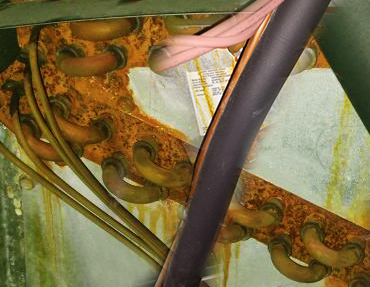
Formicary corrosion occurs in copper-based alloys and is caused by a chemical reaction containing oxygen, water, and an organic acid.
- The corrosion is usually not visible to the naked eye, although black or blue-gray deposits can sometimes be seen on the surface.
- Formicary corrosion can form a sub-surface network of microscopic corroded tunnels within the tubing wall that resemble ant nest structures. Eventually, one or more of these tunnels will progress to the surface of the copper and form a pinhole, which quickly results in coil leakage.
Localized Corrosion
Round Tube Plate Fin Coils (RTPF) and Galvanic Corrosion
Galvanic corrosion is an electrochemical process that occurs when dissimilar metals are in contact in the presence of an electrolyte, e.g., salt water. In the case of most HVAC/R equipment, this would be copper to aluminum surfaces. When a galvanic couple forms, one of the metals in the couple becomes the anode and corrodes faster than it would all by itself, while the other becomes the cathode and corrodes slower than it would alone. For galvanic corrosion to occur, three conditions must be present:
- Electrochemically dissimilar metals must be present
- These metals must be in electrical contact, and
- The metals must be exposed to an electrolyte
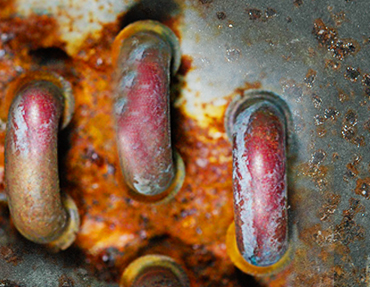
- In copper tube-aluminum fin heat exchangers (condensers and evaporators), galvanic corrosion starts at fin collars where the aluminum fins and copper tubes are in contact.
- A heat exchanger consisting of copper tubes and aluminum fins will show excessive fin loss due to the large relative electric potential difference between copper and aluminum.
- During galvanic corrosion, the aluminum fin initially corrodes at the copper/aluminum interface, as this is the point of electrical contact between the dissimilar metals. As corrosion of the aluminum fin progresses, the fin’s conductivity deteriorates, which reduces the coil thermal performance. Aluminum oxide deposits that are formed in the process can further reduce performance by impeding air flow through the coil.
Standard round tube plate fin (RTPF) condenser coils have copper tubes mechanically bonded to aluminum fins with wavy enhancements. High thermal efficiency is achieved through direct metallic contact between the tube and fin. As a result, maximum thermal performance is achieved with this high-efficiency coil design, provided there is no corrosion. While a coating that is thin enough not to interfere with coil efficiency is desirable, it also needs to be thick enough to resist galvanic corrosion.
- A common way of preventing galvanic corrosion is to break the electrical circuit between exposed metals by use of a protective coating. The protective coating in effect creates a barrier between the dissimilar metallic couple and the electrolyte, thereby eliminating the electrolyte from this interface.
Coastal/Marine
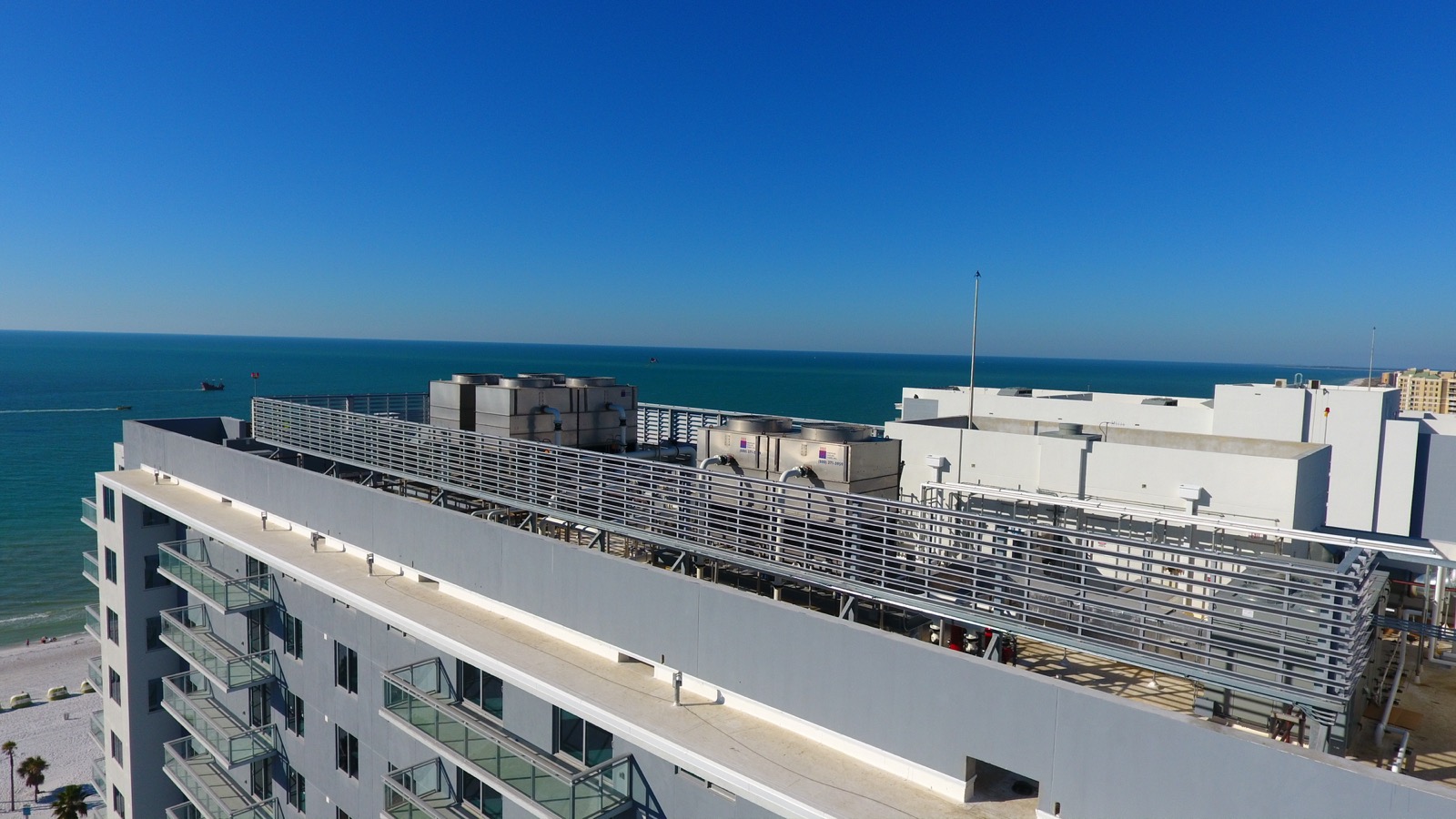
By far, the number one factor in corrosion environments is located in coastal regions where salt air is present. Coastal or marine environments are characterized by the abundance of sodium chloride (salt) and sulfur compounds that are carried by sea spray, mist, fog, or prevailing winds.
Sea spray, mist, and fog contain tiny droplets of salt water that can be transported many miles by ocean breezes and result in equipment contamination. The deposition of salt water spray onto metallic substances is the most corrosive aspect of the marine environment. Also consider the MCHE coils and the amount of water retention that is associated with these coils. During a major rain or tropical storm, these units can absorb a great deal of sea water.
Industrial

Industrial environments have the potential to produce a variety of corrosive compounds. This is especially present in industrial areas located on or near coastal waters. When you think about the chemicals produced, from chlorine to petroleum, an industrial environment can provide the same (or even greater) detrimental effect as ocean environments.
Most industrial areas emit dust particles that when combined with wind, rain, and humidity can be associated to HVAC/R pitting and formicary corrosion.
Urban
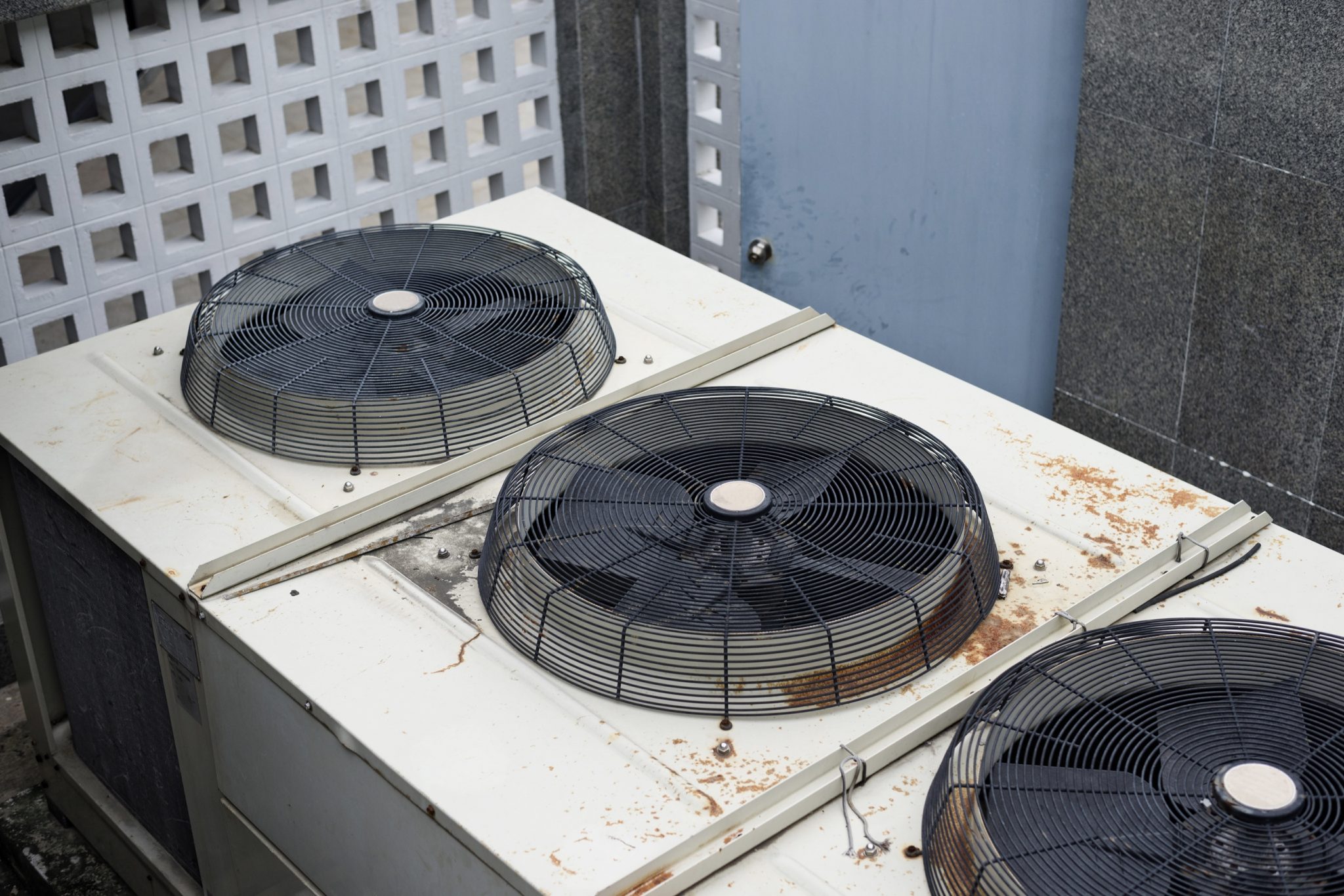
With millions of people in a dense area, you generally have a high population of automotive vehicles. Cars, trucks, and buses all emit polluting factors. Corrosion severity in this environment is a function of pollution levels, humidity, average temperature, and equipment usage, which in turn depend on several factors including population density for the area, emission control, and local pollution standards. In areas with rapid growth, contamination levels can change drastically, thus the future direction of a region should be considered when looking at the best corrosion protection system.
Any HVAC/R equipment installed near diesel exhaust, incinerator discharge stacks, fuel-burning boiler stacks, areas exposed to fossil fuel combustion emissions, or areas with high automobile emissions should be considered industrial applications.
Rural
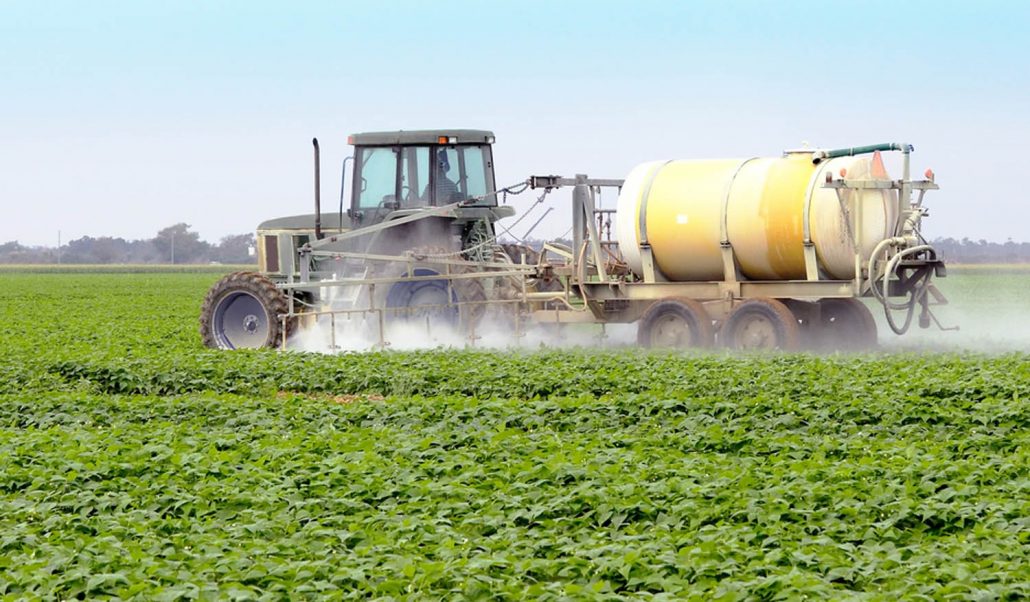
Rural environments are usually sufficiently inland and are typically regarded as unpolluted by exhaust and sulfur containing gases. Coil protection in these environments is typically not required. Before you toss that spec aside, think about this: rural environments may contain high levels of ammonia and nitrogen contamination from animal excrement, fertilizers, and high concentrations of diesel exhaust. In this case, these environments should be considered as potentially corrosive and a protective coating on your HVAC/R equipment may be required.
These environments are subject to microclimates that can significantly increase the corrosivity of the environment. Consideration should be taken to ensure that the localized environment surrounding the HVAC/R equipment does not contain contaminants that will be detrimental to the equipment.

When designing your HVAC/R equipment and considering the need for protective coatings, consider these factors as potential factors in amplifying the corrosive environment:
- Airports
- Breweries
- Chemical Factories
- Cement Producers
- Garbage Dumps & Landfills
- Farms & Nurseries
- Food Processing
- Power generators
- Power plants
- Fisheries
- Traffic
Corrosive Environments That You May Not Have Considered

All corrosion environments are not relegated to just outdoor conditions. Some indoor air-handling applications, such as swimming pool areas, water treatment facilities, and industrial process areas can also produce corrosive atmospheres. Close proximity to laundry facilities, diesel-burning devices/exhaust piping, and sewer vents can lead to premature failure of improperly protected equipment. What you may not know is that some dry wall material and carpeting can emit gases that will cause corrosion to internal HVAC equipment.
Corrosion is all around us. When designing your systems consider these regional factors into your specifications:
- Distance from contaminant source.
- HVAC/R equipment is within 50 ft (15 meters); in a macro environment, within 1 mile (1.6 km)
- Prevailing wind direction
- Temperature and humidity
- Heavy/frequent fertilizer or insecticide usage (farmland)
- Bus or truck loading areas or heavy diesel traffic
- Power generators (running full time)
- Fan-powered exhaust vents associated with industry
- Cooling towers due to drift of chemical treatments



